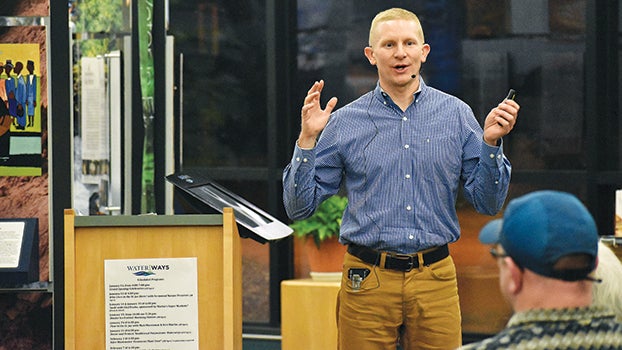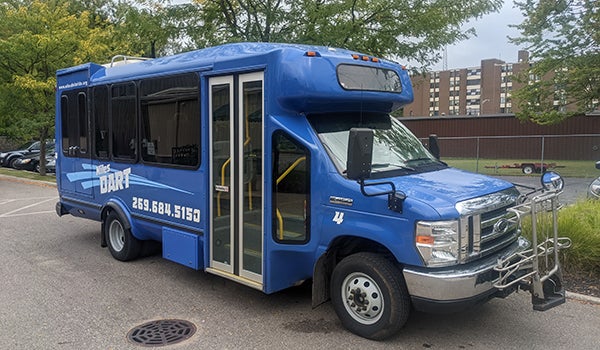Smithsonian program teaches residents how to save water, benefit property
Published 9:51 am Monday, January 28, 2019

- Matt Meersman, director of the St. Joseph River Basin Commission, speaks about the St. Joseph Watershed Thursday at the Niles District Library. (Leader photo/KELSEY HAMMON)
NILES — Saving water does not just help the planet.
For those that make an effort, it can cut costs, eliminate flooding and provide residents with a sense of doing something good for their community.
Matt Meersman, director of the St. Joseph River Basin Commission, and Kris Martin, an associate planner with the Southwest Michigan Planning Commission, shared a variety of ways residents can benefit their watershed, their property and their finances during a Flow in the St. Joseph presentation Thursday night at the Niles District Library. The program was part of the Smithsonian Water/Ways exhibit which runs through Feb. 16.
So what is a watershed and why does it matter? A watershed is all the land that flows to a body of water. In Michiana, the St. Joseph Watershed is the third largest watershed that pours into Lake Michigan. That means the efforts of Michiana residents can make a great impact on protecting and preserving the bodies of water. Meersman and Martin shared some simple ways that residents can invest in the watershed and benefit their property, too.
One of the largest threats to bodies of water is runoff from homes, roads and cities.
“It’s not coming from a single point,” Meersman said. “It’s not a single pipe. It’s coming off of our land, our houses, our roads and all kinds of different lands.”
People can capture and filter runoff from their homes by creating a rain garden. These eye-catching gardens are typically made up of native plants like purple coneflowers and yellow black-eyed Susans.
“The typical lawn, made of Kentucky Bluegrass, has a root system of just a few inches,” Martin said. “But some of these native plants can have roots up to 10 feet. It’s really great at managing storm water and native plants don’t need a lot of artificial growth or chemicals or a lot of heavy watering.”
Rain gardens also help to provide habitat for local birds and butterflies. Those looking to plant a rain garden should make sure that there are no utility lines in the way. Residents can call 811 to find out. Soil should be a composite of sand, compost and stone.
To capture more water runoff and save on water utilities, Meersman and Martin recommended using a rain barrel to catch water from roof gutters. While this water will not be drinkable, it can be used to water lawns and gardens.
Reporting invasive species, like the Japanese Knotweed, can protect infrastructure from damage. People can make a report by visiting the Midwest Invasive Species Network website. Assuring that boats, paddles and anything else that people use for recreation is clean is another way to keep invasive species from spreading.
Meersman and Martin also suggested a few things people should not do that can significantly impact water quality.
Residents should never put anything but rain in the drain. All household cleaners and other chemicals should be properly recycled. Organizations like the Southeast Berrien County Landfill offer recycling days for this purpose.
Meersman is a self-proclaimed water enthusiast. When he is not at work, Meersman is usually spending time in the water. As a marathon canoer, he has paddled many sections of the St. Joseph River in the Michiana area.
“You spend that kind of time on the water, you want to protect it,” Meersman said. “You want to be able to swim in it.”
He said residents are not the only ones who have fought to keep water sources clean. In the 1970s, the Clean Water Act was initiated with the goal of making all U.S. waterways, swimmable and drinkable. Locally, efforts from the St. Joseph Basin Commission, which started in the 1980s, sought to improve local waterways and initiate local discussion.
Meersman said local efforts are made apparent by the proliferation of life in the water.
In the early 1900s, Meersman said there were only five species of fish alive in the St. Joseph River. Today, there are nearly 50 varieties of fish swimming through the St. Joseph River, Meersman said. That life indicates that there has been a significant improvement to the local waterway, but there are still strides to be made in protecting the resource. Meersman said last year’s flood in Niles is a testament to that.
“We had our worst flood on record just this last February, and I think there is a connection between that keeps getting worse and while we are not where we want to be with water quality,” Meersman said. “Both of those things are connected.”
Cities like South Bend have implemented practices aimed at better capturing water, including brick sidewalks, where water can filter through the cracks. Smart Sewers are also used to direct water during storms to pipes that are not flooded – keeping mass amounts of water from flooding water treatment plants. When a treatment plant is over capacity, they have to release untreated water into waterways.
The development of the natural landscape into large swaths of agricultural area is another factor. To combat this, some farmers today use no-till methods and cover crops to reduce runoff and keep the nutrients in their soil. Without these methods, water washes away dirt, clogging agricultural ditches.
Most importantly, Meersman and Martin emphasized that the biggest change people can make to protecting local water is a change in behavior.
“It’s about slowing the flow down, soaking it in,” Meersman said. “Thinking about water as a resource, rather than a waste product. I think historically and even today, we think of water as something we need to get rid of. We want to think about it as something precious.”






